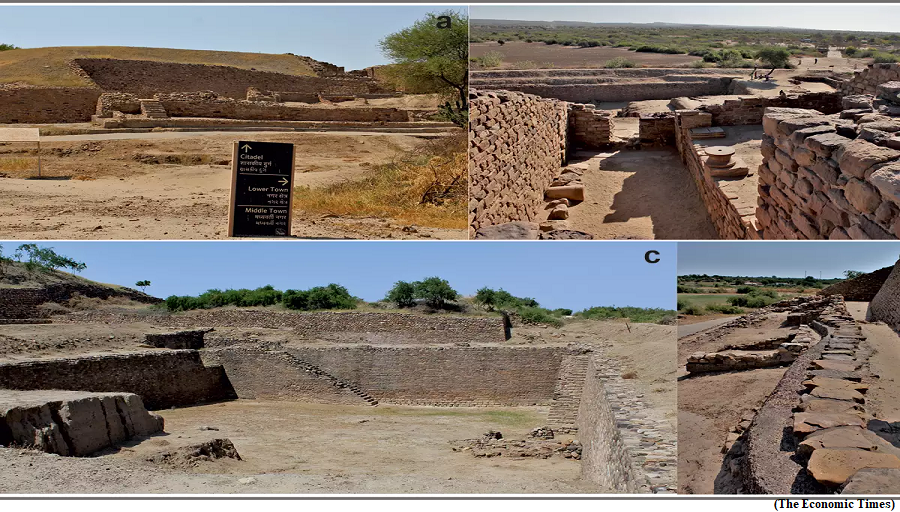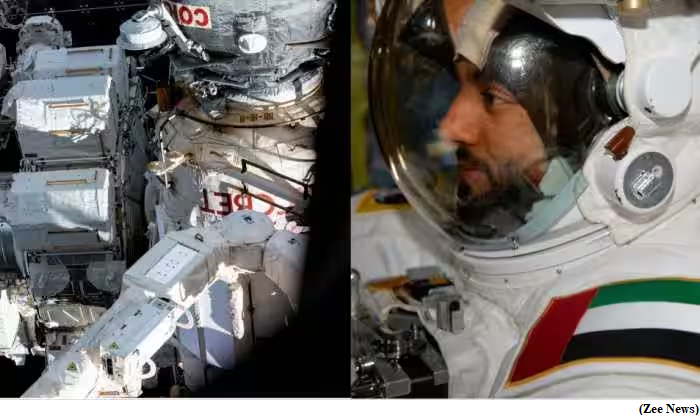Harappa, Rakhigarhi, Dholavira, 200 years of droughts may have erased these Indus megacities, says study (GS Paper 1, History)

Why in news?
- Climate change has long been associated with the fall of the ancient Indus civilisation, and a new study of evidence from a Himalayan cave established that prolonged droughts during the Bronze Age may have snuffed out the life of the people in the region.
- Droughts that began 4,200 years ago gripped the civilisation spread over present-day Pakistan and India, and went on for over two centuries.
How research was conducted by the University of Cambridge?
- The scientists recovered a stalagmite from a cave near Pithoragarh district in India’s Uttarakhand. They studied the layers of this stalagmite to assess relative seasonal rainfall over thousands of years.
- They also used high-precision Uranium-series dating to get a handle on the age and duration of the droughts.
Key findings:
- They found indications of three droughts lasting 25-90 years each during the dry 200 years. This period also coincided with the time when the civilisation was building cities.
- They identified distinct periods of below-average rainfall in both the summer and winter seasons.
- Much like what countries across the world are experiencing today due to climate change; the protracted droughts severely affected food systems and habitation patterns, among other things.
Adaptation:
- This forced the people of the Indus Civilisation to make systemic changes to adapt to the changing environment.
- They reorganised their large cities and moved towards the east of the region in smaller rural settlements.
- They also had to make changes to their agricultural practices relying more on drought-resilient crops such as millets.
- The population adopted a more self-reliant lifestyle as a means of climate adaptation.
What’s next?
- They will now attempt to make similar climate reconstructions for the western parts of the Indus River region, where the winter rainfall system becomes more dominant than the Indian Summer Monsoon.
Bio-aviation committee discusses ways to reduce carbon emissions
(GS Paper 3, Environment)
Why in news?
- A committee on bio-aviation turbine fuel programme, constituted by the Petroleum & Natural Gas Ministry, has submitted its report on promoting the use of clean fuel in aviation.
- Recently, the consultative committee of the Civil Aviation Ministry, discussed Sustainable Aviation Fuel (SAF) during a meeting that was attended by several Parliamentarians.

Commitments:
- The International Civil Aviation Organization (ICAO) is facilitating reduction of carbon emissions in civil aviation and its goals include achieving two per cent annual fuel efficiency improvement through 2050.
- India has committed to net zero by 2070 at COP26 to the United Nations Framework Convention on Climate Change (UNFCCC).
National Policy on Bio Fuels:
- The Ministry of Petroleum & Natural Gas (MoPNG) has notified a National Policy on Bio Fuels 2018 to realise the goal of de-carbonisation of the aviation sector.
- MoPNG constituted the Bio-Aviation Turbine Fuel Programme Committee to take forward the Bio-ATF Programme in the country to promote the use of clean fuel in aviation.
Various initiatives:
- Indian Oil Corporation Ltd (IOCL) has planned an 86.8 TMTPA plant at Panipat using LanzaJet ATJ (Alcohol To Jet) Technology.
- IOCL has also signed a MoU with Pune-based Praj Industries to set up a plant for developing ATJ fuels.
- Besides, Mangalore Refinery and Petrochemicals Ltd is planning to build a bio-ATF pilot plant at Mangalore using CSIR-Indian Institute of Petroleum's technology using non edible oils and used cooking oil as feedstock.
SAF-blended fuel:
- The Directorate General of Civil Aviation (DGCA) has granted approval for AirAsia India to operate the first commercial domestic flight with 0.57 per cent SAF-blended fuel.
- In August 2018, SpiceJet operated a demonstration flight with 25 per cent SAF from Dehradun to Delhi. The biofuel was produced from Jatropha seeds by Indian Institute of Petroleum, CSIR lab.
- Vistara, in March 2023, operated a ferry flight with 30 per cent blended SAF from Seattle to Delhi, while IndiGo operated a ferry flight with 10 per cent blended fuel from Toulouse to Delhi in February 2022.
CORSIA:
- ICAO has taken various steps to reduce emissions, including the Carbon Offsetting and Reduction Scheme for International Aviation (CORSIA) and the Long Term Aspirational Goals (LTAG).
- CORSIA is being implemented in three phases and participation is voluntary in the first two phases; 2021-2026.
- India has decided not to participate in the voluntary phases of CORSIA. Offsetting requirements under the CORSIA for Indian carriers will start from 2027.
- CORSIA is applicable to international flights originating from one country to another. Financial implications due to offsetting will be borne by individual airlines depending upon their international operations as and when applicable.
Way Forward:
- In India, several meetings have been held with domestic carriers to sensitise them regarding the impact of CORSIA on airlines once the mandatory phase starts.
- India has also taken several steps like joining ICAO's Assistance Capacity Building & Training for Sustainable Aviation Fuels Programme.
UAE’s Sultan Al-Neyadi becomes first Arab astronaut to walk in space
(GS Paper 3, Science and Tech)
Why in news?
- Sultan Al-Neyadi who hails from the United Arab Emirates has become the first Arab astronaut to walk in space as part of a space mission named ‘Expedition 69’.

Details:
- The astronaut ventured out from the International Space Station (ISS) and completed his spacewalk.
- The spacewalk lasted 7.01 hours in the vacuum of space on the starboard side of the ISS' truss structure, accomplishing two key objectives.
Challenges:
- Prior to the spacewalk, a thorough set of checks were conducted to ensure the safety of the astronauts.
- During their high-altitude walk outside the ISS, Al-Neyadi and Bowen had to contend with two major challenges: radiation and extreme temperatures.
- The surrounding environment in space can reach scorching temperatures of up to 120 degrees Celsius in the sunlight and drop as low as -150 degrees Celsius when the sun is out of sight.
- While the spacesuit is geared to handle all this, careful management of the suit during the mission was also a task at hand.
UAE Astronaut Programme:
- The UAE Astronaut Programme is one of the projects managed by the Mohammed Bin Rashid Space Centre under the UAE's National Space Programme.
- It is funded by the ICT Fund of the Telecommunications and Digital Government Regulatory Authority, which aims to support research and development in the ICT sector in the UAE and promote the country's integration on the global stage.
Significance:
- Al-Neyadi will soon be completing two months in space after launching from Cape Canaveral in Florida with his Crew-6 team members on March 2.
- This milestone achievement will play a critical role in restoring the International Space Station to its full operational capability, cementing the UAE's position as a leading contributor to the global space community.




